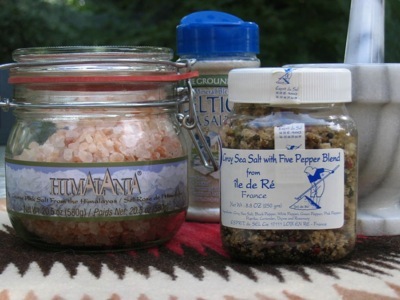
Posting an entire segment on salt may seem a touch strange, but I’m curious about all the flavoring additions to cooking and baking and salt is one of the most important ones for seasoning foods. As a food preservative, it played a contributing role in the development of civilization and was a very precious commodity. History even suggests that Roman soldiers were paid with salt. The term salary derives from the Latin word sal or salarium, hich translates to salt. Wars were fought over salt. Weren’t they? Wasn’t there the War of Salt, or the Seven Year Salt War? Maybe not, but it was definitely an important part of early trade and commerce. It’s even mentioned several times in the Bible. Don’t ask me where.
Back to the basics. Salt draws moisture out of food so bacteria can’t grow, hence it’s evolvement as a food preservative. Today it’s used heavily in processed foods; it adds flavor, reduces dryness in crackers and snack foods, increases sweetness in cookies and cakes, and even helps mask the chemical and metallic aftertaste in canned sodas and soft drinks. Yuck. Most people get more than the recommended 1,500 to 2,000 milligrams of sodium per day because of the amount of processed foods they eat. As always, minimize processed and refined foods and go for whole, nutrient-dense choices instead.
Sea salt and salt mined from the earth are harvested from the ocean or remnants of ancient oceans and salt lakes. These versions are evaporated and sun-dried and contain trace elements that are missing from fully refined or chemically manipulated table salt, but also don’t contain the iodine levels that are added to table salt. Sodium (the primary constituent of salt; either version), is one of the electrolyte minerals we need for normal cell function. But we’ve all heard that overuse of salt can cause kidney problems and high blood pressure, so balance and moderation are important.
I prefer Celtic Sea Salt as it has a mellow taste and is more flavorful than commercial salt, which tastes a bit “chemically” to me by comparison. I also much prefer the texture of sea salt. The fact that it is hand-harvested and solar evaporated (sun dried) using traditional methods is appealing to me as well. This has been the process for thousands of years. But spending the extra money for sea salt doesn’t necessarily guarantee you’re getting a better product. It does take some effort to figure all this out, but from what I’ve learned, Celtic Sea Salt is harvested by salt farmers (paludiers) in one of the most pristine coastal regions of France. It contains trace elements that are refined out of table salt and the company states that they also test for heavy metals which can be a problem with some sea salts depending on the area where the salt is harvested. Celtic Sea Salt lab results (under FAO/WHO Codex standards) state there were no detectable levels of arsenic, cadmium, or mercury in their products, which is definitely a good thing.
Whichever salt you use to season your food, use in moderation and try adding various herbs and spices to enhance flavors. Be creative and have fun playing with your food!













